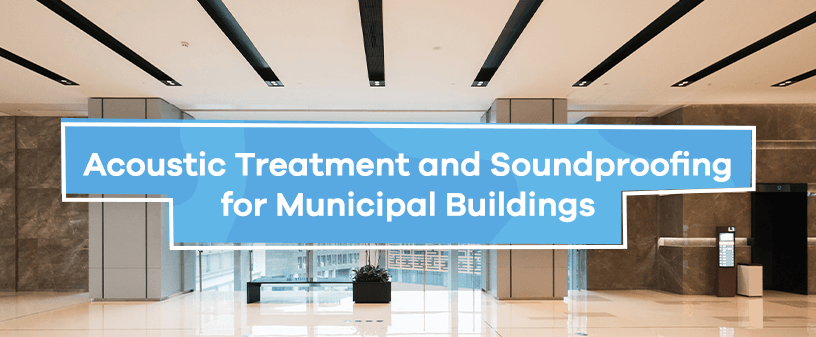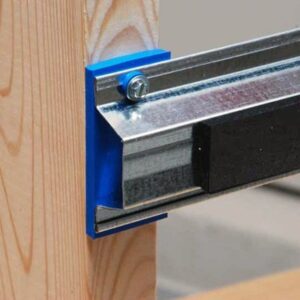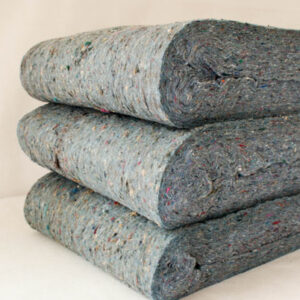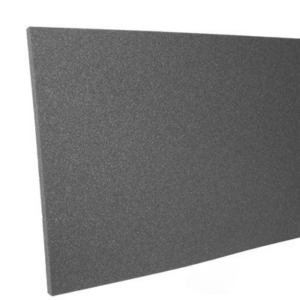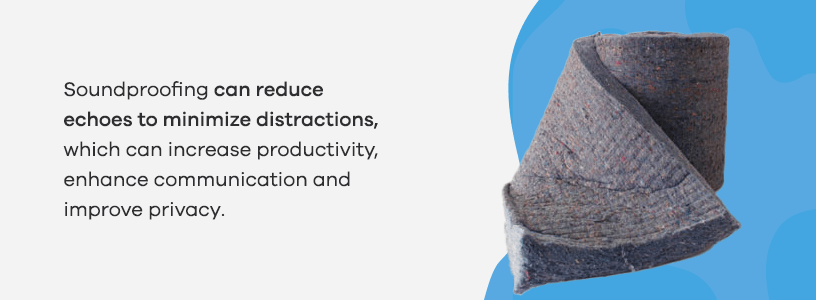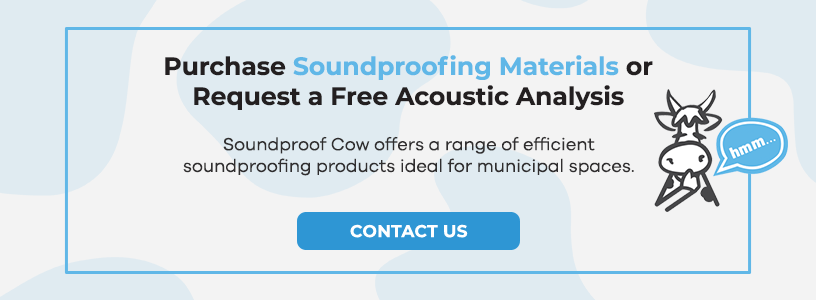
Municipal buildings are essential to communities, but noise pollution can distract from the important decisions being made there. Acoustic treatment for courthouses and other municipal buildings can help maintain a peaceful environment for meetings. There are lots of soundproofing techniques and materials to choose from, so finding the right solutions can be challenging. Never fear — we are here to help.
Let’s get moo-ving into the importance of soundproofing municipal buildings and the most suitable materials for doing so.
Municipal Building Soundproofing Products
Municipal Building Sound Absorption Products
Reasons to Soundproof a Municipal Building
These buildings are typically expansive, with large open rooms and high ceilings. These elements can amplify noise pollution, as sounds bounce off walls with nothing to absorb them. Impact noises from foot traffic, moving chairs and other actions are just as distracting. Without soundproofing, these noises become louder.
Soundproofing techniques for municipal buildings can reduce echoes to minimize distractions, which can increase productivity, enhance communication and improve privacy. Pretty important benefits for municipal buildings, we’d say.
Municipal Buildings That Can Benefit From Soundproofing
Municipalities provide vital services, from water and electricity to sanitation, trash removal and recreation. And that does not even cover the duties of courthouse officials and police officers. The following municipal buildings can benefit from soundproofing techniques that reduce echoes.
Courthouses
Courtrooms need superior acoustics. Because these rooms are typically large and void of furnishings other than hard chairs, sounds can openly bounce back and forth with no absorption materials to slow them down. As a result, there will be a distracting echo in courtrooms that don’t have sufficient soundproofing. Soundproof courtrooms strive for shorter reverberation time because it leaves a smaller chance of the speaker’s message getting diluted.
Without soundproofing, echoes from whispering community members could interfere with court proceedings. Additionally, the judge and jurors may have difficulty hearing prosecutors, advocates, defendants and victims. For all these reasons, courtrooms need unique soundproofing plans that amplify speech in the counsel table area and provide speech privacy near the judge.
Police Stations
In police station interview rooms, acoustics are essential. Collecting crystal-clear recordings of witness and suspect statements is vital, as these transcripts are valuable evidence in court proceedings.
If interviews are carried out in regular rooms, sound will bounce around the room’s walls and ceiling, while sounds from outside can leak in through doors, interfering with acoustics and reducing audio quality. This is problematic because audio files may be unusable if even part of the dialogue is unintelligible. Soundproof police station interview rooms can help avoid these issues.
Municipal Admin Buildings
Municipal administrators are the link between the municipality and the local community. They have several responsibilities, including informing the community of services they are entitled to.
These buildings see a lot of foot traffic and a lot of noise. Because they are large and generally have high ceilings, good acoustics make it possible for municipal administrators to establish clear lines of communication. Ongoing chattering noises are less distracting with proper acoustics.
Parks and Rec Facilities
This municipal service provides the community with picnic areas, parking, pavilions and other facilities, such as indoor recreational spaces. Within these expansive indoor spaces, bouncing sounds can create an unpleasant experience, making soundproofing solutions valuable.
How to Soundproof Municipal Buildings
Check out how to soundproof different parts of municipal buildings below.
Soundproofing Walls
The process for soundproofing a new wall requires nailing soundproofing materials to the studs of the wall. The seams of the material must fit closely to prevent sound leaks. After that, builders can install Type X gypsum board or drywall, leaving a quarter-inch gap between the board and the adjoining surface. Then, secure Quiet Batt® Soundproofing Insulation between the studs. On the opposite side of the wall, install the isoTRAX® Soundproofing System onto the studs and install gypsum board over the top. Fill the quarter-inch gap with OSI® Pro-Series® SC-175 Acoustical Sound Sealant.
The process and materials are similar when soundproofing an existing wall. Locate and mark the studs before installing the Quiet Barrier® HD Soundproofing Material. Seal the seams and place the isoTRAX® system over the barrier layer, followed by the gypsum board. Fill the gap with the OSI® Pro-Series® SC-175 Acoustical Sound Sealant, and finish the gypsym board according to industry standards.
If you want to dampen sounds without the in-depth construction, fabric-wrapped, wall-mounted or art acoustic panels can help!
Soundproofing Ceilings
For new ceilings, install the Quiet Batt® Soundproofing Insulation between ceiling joists. Next, fasten the isoTRAX® system onto joists around the insulation. Install Type X gypsum board on the tracks, leaving a quarter-inch of space between the board and the adjoining walls. Seal the gap with the same sealant mentioned above.
You will need to locate and mark the studs when dealing with existing ceilings. Then, install Echo Absorber™ Acoustic Panels between the tracks and cover everything else with gypsum board, leaving — you guessed it — a quarter-inch of space between the adjoining walls and the gypsum board. Seal this space with your sealant.
You can also hang acoustic panels from the ceiling to effectively absorb and dampen sounds.
Soundproofing Floors
The process and materials used to soundproof floors depend on the type of flooring:
- Hardwood: We recommend the PROFLEX™ 90 Flooring Underlayment. Its rubberized membrane is laminated to increase effectiveness, and it’s waterproof to prevent cracking.
- Floating hardwood: For floating hardwood floors, use the Impact Barrier QT Flooring Underlayment. This material is mold- and mildew-resistant, which suits this type of flooring.
- Stone and ceramic: Stone and ceramic flooring is a bit more challenging to soundproof, but we recommend PROFLEX™ 90.
- Carpet: For carpeting, the process is straightforward. The Impact Barrier QT Flooring Underlayment is the best option and will reduce noise from rooms below and from within the room.
- Laminate and engineered flooring: The Impact Barrier QT Flooring Underlayment is also an excellent option for this flooring type.
Soundproofing Doors
It can be costly and complicated to soundproof a door completely. However, there are more economical solutions, such as door sweeps and seals. The Quiet Door™ Adjustable Perimeter Seal can minimize sounds by creating a sound-tight seal around the door. The Quiet Door™ Automatic Door Sweep is another sound-blocking solution that fits along the bottom of the door to form a seal when the door is closed.
There are also acoustic panels for doors, like the Quiet Door™ Acoustic Panels. These panels are secured to the door to absorb sound. They are made from a visco-elastic polymer composite and a dense fabric layer and are relatively easy to fit. A caulking sealant like the OSI® Pro-Series® SC-175 Acoustical Sound Sealant can reduce noise leaks from around the door edges.
Purchase Soundproofing Materials or Request a Free Acoustic Analysis
Soundproof Cow offers a range of efficient soundproofing products ideal for municipal spaces. Whether you need soundproofing for police station interview rooms, courtrooms or any other municipal building, our quality products are designed to absorb and reduce noise pollution.
Browse our soundproofing products, or contact us online and one of our courteous team members will answer your questions. You can also get a free acoustic analysis and get expert advice!
Soundproof Other Spaces



